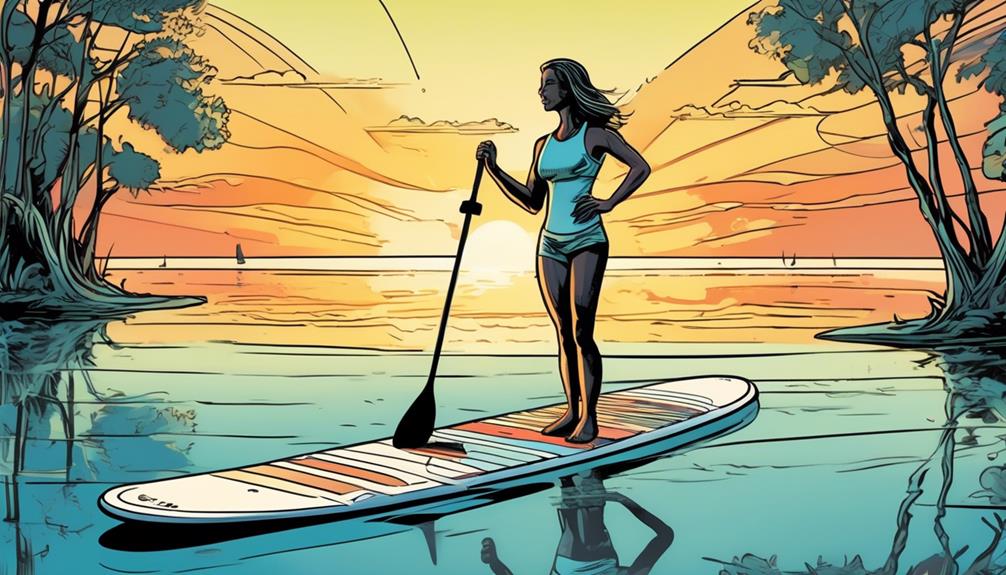When I first got on a 10-foot inflatable paddle board for yoga, it totally changed my game.
Here's the deal: the size of your board isn't just about how tall it is. Width and thickness are game-changers for keeping your balance and feeling comfy during those tricky poses.
If you're feeling overwhelmed by choices, you're not alone. But stick with me, and I'll walk you through how the dimensions of your board can affect everything from maneuverability to comfort based on solid data. Plus, I'll factor in your personal size and how seasoned you are at paddleboard yoga.
You want to find that sweet spot, right? A board that feels like it was made for you, making your yoga sessions on the water something you'll look forward to.
Let's get you set up with the perfect match, and trust me, with the right info, you won't be shooting in the dark.
Key Takeaways
- The optimal dimensions for a yoga paddle board are around 10 to 11 feet long and 32 inches wide.
- Stability and balance are crucial for successful yoga poses on a paddle board, and boards around 32 to 34 inches wide offer a stable platform without compromising movement.
- Personal size and paddling experience should be considered when selecting the right board, with taller individuals or those with more muscle mass benefitting from larger boards.
- Experimenting with different board sizes and listening to your body's needs can lead to finding the perfect board for your paddleboard yoga practice.
Understanding Board Dimensions

If you're like me, always on the hunt for that perfect yoga session on the water, you've probably realized not all inflatable paddle boards are up to the task.
Let's get straight to the point: size matters. And by size, I mean both the width and length of the board. You might be thinking, 'Okay, but how much of a difference does it really make?' Well, let me break it down for you with some real talk and data-driven insights.
First off, width. Through trial and error (and believe me, there were plenty of errors), I've found that a wider board significantly boosts your stability. Think about it: attempting a Warrior Pose on a wobbly surface is no joke. Data backs this up; boards around 32 inches wide tend to offer that sweet spot of stability without turning your board into a floating island that's impossible to maneuver.
Now, onto length. It's not just about having the space to stretch out; it's about the range of movements. With a board that's too short, you're basically limiting your yoga flow to a cramped space, which is the opposite of what yoga is about. After experimenting with various sizes, I've pinpointed that boards ranging from 10 to 11 feet long give you enough real estate to move freely and confidently into each pose.
You might be skeptical, thinking, 'Can a few inches really make that big of a difference?' Yes, they absolutely can. Imagine trying to balance on a beam — the wider it is, the easier it's to find your footing. The same logic applies to paddle boards.
So, if you're serious about taking your yoga practice to the water, choosing a board with the right dimensions isn't just a suggestion; it's a game-changer. Opting for a board that's around 10 to 11 feet long and 32 inches wide not only offers the optimal balance but also ensures you have the space to execute a full range of yoga poses.
Balance and Stability Considerations
If you're serious about nailing those yoga poses on a paddle board, listen up. It's not about how flashy your board looks. Nope. It's all about stability and balance.
Ever tried transitioning into a warrior pose on something that feels like it's dancing on water? Not fun. But then again, a board that feels like a floating dock isn't the answer either. You're looking for that Goldilocks zone where your board is just right.
After tons of trial and error, I've found the magic numbers. Boards around 32 to 34 inches wide hit the sweet spot for most of us yogis out there. Why? They offer a stable platform that doesn't kill the vibe of moving with the water. It's like having a solid foundation that still lets you flow.
And when it comes to thickness, going for a board that's 6 inches thick is a game changer. It's sturdy enough to support more weight without turning your session into a balancing act on a bending noodle.
I've personally experienced the transformation in my water-based yoga sessions by choosing a paddle board with these dimensions. It's a balance (pun intended) between not falling into the water every other pose and still feeling connected to the fluid movements of yoga. You get to focus on your poses, breathing, and soaking in the nature around you, without the constant fear of taking an unplanned swim.
So, if you've been struggling with finding the right board, consider these dimensions as your starting point. It's not just me raving about this. Data backs it up. Boards within these size ranges have consistently provided the best stability and flexibility balance for a wide range of yogis, from beginners to the more advanced.
Trust me, once you find that perfect board, your practice on water will never be the same. And isn't that the point? To challenge yourself but also enjoy every moment of it? Choose wisely, and see how your water yoga game changes for the better.
Maneuverability Vs. Comfort

When I'm out on my paddleboard, teetering between wanting to nail a new yoga pose and not tipping into the water, I've had to make some choices. It's a balancing act between maneuverability and comfort, and trust me, it makes a huge difference in your practice. But let's break it down with some real talk and data-driven insights.
Here's the deal: a smaller board is your go-to for slicing through the water, perfect for those serene spots you've eyed for your yoga session. The numbers back it up – smaller boards, often around 10 feet or less, are nimble, making them ideal for tight turns and quiet explorations. But here's the kicker: when you're floating in the middle of a calm lake trying to strike a warrior pose, the last thing you want is a wobbly board. You're aiming for a platform that feels like it's part of the water, not fighting against it.
Enter the larger board. We're talking boards that stretch beyond 12 feet, offering a deck that's as stable as your living room floor. This is where comfort plays its part. A larger surface area means more room for your poses and less mental energy spent on balancing. The stability is a game-changer, especially when you're attempting poses that require focus and balance.
But wait, there's a middle ground – the hybrid size. Think of it as the Swiss Army knife of paddleboards. It's designed to give you enough room to stretch out and hold a pose without tipping over, while still being agile enough to take you to your favorite secluded spot. A board that's around 11 feet hits this sweet spot, blending the best of both worlds.
Now, speaking directly to you, the skeptical reader, you might be thinking, 'Sure, but what's the best choice for me?' The answer lies in what you value more. If exploration and getting into tight spots are your priorities, a smaller board might be your best bet. But if you're all about those sunrise yoga sessions on the lake, consider leaning towards comfort with a larger board.
From personal experience, testing different board sizes has been eye-opening. I've found that a hybrid-sized board offers the stability I need for a solid yoga practice while still being light enough to maneuver through serene waters. It's about listening to your body and understanding your priorities.
Personal Size and Experience
So, you're eyeing the paddleboard yoga scene, huh? I've been there, done that, and let me tell you, the size of your board can make or break your experience. Let's cut to the chase: your personal size and paddling experience are game-changers in finding that perfect board.
If you're on the taller side or pack a bit more muscle, a larger board will be your best friend. It's not just about feeling comfy; it's about staying afloat and nailing those poses. I learned this the hard way when I started with a smaller board, thinking it'd be easier to control. Big mistake. Every pose felt like a battle against tipping over.
Now, if we dive into the nitty-gritty, data shows that individuals over 6 feet tall or weighing more than 200 pounds should opt for boards at least 32 inches wide. This isn't just a number pulled from thin air; it's grounded in the physics of balance and buoyancy.
Experience-wise, it's a similar deal. For the seasoned paddlers among you, a narrower board might seem appealing. You've got the skills, sure. But, let me lay down some facts: even with experience, a board too narrow can amplify the challenge in unpredictable water conditions or when trying advanced poses. I've seen skilled paddlers get humbled by their overconfidence in their board choice.
For beginners, I can't stress this enough: start wide. A board with a width of 33 inches or more isn't just forgiving; it's a confidence builder. Remember, confidence in paddleboard yoga is half the battle. You're learning to balance on water while doing yoga – it's like patting your head and rubbing your belly while on a balance beam.
Consider this: studies have shown that beginners on wider boards progress faster in their practice, as they spend less time worrying about falling and more time focusing on the poses. It's a psychological edge as much as a physical one.
To wrap this up, choosing the right board size isn't a 'one size fits all' kind of deal. It's about matching your body and skill level for an optimal experience. From personal experience, taking the time to find the right fit has transformed my paddleboard yoga sessions from frustrating to exhilarating. So, assess yourself honestly, consider the data, and pick a board that'll turn your yoga journey on water from shaky to sublime. Trust me, it's worth it.

